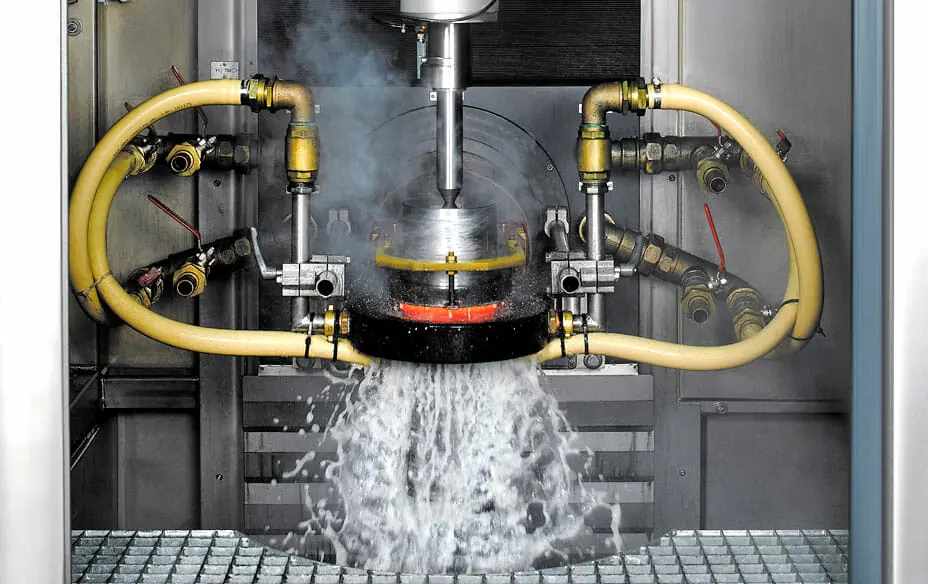Induction Hardening
With induction hardening, the edge of a workpiece is heated quickly and then quenched by the plant (hardened). Long cylindrical components can be hardened inductively using our medium-frequency hardening system (hardening length of up to 5,000 mm).
Advantages
- High surface hardness, tough core
- Improves resistance to wear and tear
- Partial hardening
- High reproducibility
Materials
- Tempered steels
- Tool steels
- Stainless steels
- Casting materials
Available plant sizes
- Plant MF, length 5000 mm, diameter 600 mm

Typical Values for Induction Hardening
Which materials can be hardened inductively and what hardness is achieved? The table shows commonly used steel grades and cast materials for induction hardening as well as the achievable case hardening depth and surface hardness.
| DIN EN 10027-2 Material number | DIN EN 10027-2 (Short) designation | Edge hardness [HRC] | max. Case depth SHD [mm] |
|---|---|---|---|
| Tempered steel | |||
| 1.1181 | C 35 E | 48-55 | 6 |
| 1.1191 | C 45 E | 54-61 | 6 |
| 1.1221 | C 60 E | 57-64 | 6 |
| 1.5067 | 36Mn5 | 51-57 | 6 |
| 1.5122 | 37MnSi* | 53-58 | 6 |
| 1.5141 | 53MnSi* | 56-62 | 6 |
| 1.7005 | 45Cr2 | 54-60 | 6 |
| 1.7033 | 34Cr4 | 49-56 | 6 |
| 1.7220 | 34CrMo4 | 50-57 | 6 |
| 1.7225 / 1.7227 | 42CrMo4 / 42CrMoS4 | 52-59 | 6 |
| 1.6580 | 30CrNiMo8 | 48-55 | 6 |
| 1.6582 | 34CrNiMo6 | 49-56 | 6 |
| 1.8159 | 50CrV4 | 55-62 | 6 |
| 1.8161 | 58CrV4 | 57-63 | 6 |
| Tool steel | |||
| 1.2344 | X41CrMoV5.1 | 53-60 | 6 |
| 1.2327 | 86CrMoV7 | 58-64 | 6 |
| 1.2080 | X210Cr12 | 54-60 | 6 |
| 1.2083 | X40Cr13 | 54-57 | 6 |
| Stainless steel | |||
| 1.4112 | X90CrMoV18 | 54-57 | 6 |
| 1.4535 | X90CrCoMoV17 | 54-57 | 6 |
| 1.4125 | X105CrMo17 | 55-60 | 6 |
| Ball bearing steel | |||
| 1.3505 | 100Cr6 | 60-65 | 6 |
| Valve steel | |||
| 1.4718 | X45CrSi9 3 | 55-60 | 2 |
| 1.4747 | X80CrNiSi20 | 51-55 | 2 |
| Casting materials | |||
| 0.6025 | EN-GJL-250 (GG25) | 46-52 | 2 |
| 0.7050 | EN-GJS-500 (GGG50) | 52-57 | 2 |
| 0.7080 | EN-GJS-600 (GGG60) | 52-58 | 2 |
| 0.7070 | EN-GJS-700 (GGG70) | 55-62 | 2 |
* Malleable, but susceptible to cracking. The maximum hardness is determined by the material. All statements without guarantee.
Downloads
Want to read up a bit? Need details? No problem, simply download the information you need.
